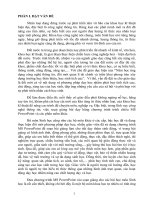Xử lí hình ảnh trong báo cáo khoa học
Bạn đang xem bản rút gọn của tài liệu. Xem và tải ngay bản đầy đủ của tài liệu tại đây (5.52 MB, 40 trang )
Chuyên đề:
Xử lí hình ảnh
trong báo cáo khoa học
Content
•
•
Tìm kiếm hình ảnh trong báo cáo
Yêu cầu của Figures & Tables trong kết quả thí nghiệm
Finding images???
•
Wikimedia Commons Images are contributed by photographers who have the authority and desire to offer copyright-free images. Give a
link to the image in Wikimedia Commons and, when available, the name of the creator of the item.
•
•
•
PNAS Online(the Proceedings of the National Academy of Sciences). Permission is granted to use the images for educational purposes.
Scientific American and Nature have some beautiful images for posters; permission to use images can be requested.
Science has a wealth of high resolution images. You must request permission to use these images for display purposes (e.g. for Student
Symposium)..
•
Google’s Advanced Image Search: For Size, select Large. For Usage Rights, select “free to use.”
Use Google's main image search to find the origin of an online image or a larger version:
In the search box, click the camera icon to search by an image's URL or to upload an image from your computer.
•
Prints and Photographs Reading Room (Library of Congress) does not have scientific images at this time, but included in this digital
collection are images from the early days of the conservation movement. Most are free to use for educational purposes.
Citing image???
•
•
to assist retrieval of the image at a later date.
it is best to include a date of retrieval
in your references
Figure 2. “Water lily [Nymphaeaceae] blooming in Saint Petersburg’s Botanical Gardens, September 2005,” by A. L. Olsen. Retrieved
2011 from the NBII (National Biological Information Infrastructure) Digital Image Library website, maintained by the Center for
Biological Informatics of the U.S. Geological Survey, />
Figures
•
•
Figures come in two types: graphs and images/diagrams.
•
Images and diagrams are more likely to be used to help explain concepts or theories.
showing trends or patterns of relationship.
•
Graphs are typically used to present your data in a form that is easy for the reader to
understand.
It is important to realize that figures do not act as a replacement for text. You should
still explain concepts and theories and present your data in written English. The
figures help the reader to understand what you have written.
Figure (cont)
•
•
•
ask yourself why you are doing so???
Look better in presentation?
Must serve a purpose. used to emphasise
certain aspects of your data
•
Do your images/diagrams actually help? If
not, discard them
Titling of Figure
•
•
Numbering all of Figures. There should be a short and concise title
Titles for figures appear below the figure itself. An example of a titled graph is given
below.
•
Capitalise 1
st
word and hightlight emphasizing word
Figure 2: UVB acts at both the switch and the switched pathway to trigger UV-induced apoptosis. DNA photoproducts trigger phosphorylation of
P53 and Mdm2, thereby reducing P53 degradation. In many systems, the elevated P53 triggers apoptosis by transcriptionally activating Bax, Bak,
Puma, PIGs, and Noxa, as well as acting directly at mitochondria. For UVB-induced apoptosis, however, a larger signal proceeds through a pathway
in which UV-induced P53 inactivates E2f1, as described in the text. Graded doses of UV cause the P53–E2f1 regulatory apparatus to transition from
a fully OFF p53
−/−
-like state to a fully ON E2f1
−/−
-like state. The apoptosis-inhibitory activity of E2f1 acts through Bcl-2, which suppresses the
information flow in a direct pathway that is triggered by UV even when the P53–E2f1 regulatory apparatus is removed. P53 disinhibits this
pathway. Two secondary signaling pathways (dotted lines) are appreciable when basal Bcl-2 is low, as described in the text.
•
Graphs Specifically
Labelling. there are two pieces of information that should be labelled within the
graph: (a) axes and (b) data series
Figure 3: Triptolide induces apoptosis in endometrial cancer via a p53‑independent mitochondrial pathwa
Color of Figure
•
Colours. All graphs should be in greyscale, i.e. black, greys and white. You can
also use patterns to help distinguish different columns, or different markers
(such as circles, squares and crosses) when presenting line graphs. But you
should not use coloured graphs.
Should not
Should
Except: poster, a talk in project
Notice about colors
•
•
•
•
Colors is not detracting:
Reproducibility
Color blindness
Deficiencies
Amount of information
•
•
•
Don’t be tempted to put too much information in a single graph. You can
always use more than one!
Think about what you want the graph to say, and include just enough information
for it to make that point.
You can also group several graphs together, such as in Figure 3 below
Figure 3: Triptolide induces apoptosis in endometrial cancer via a p53‑independent mitochondrial pathway
Graphs format
Images and Diagrams Specifically
•
can be very useful for explaining models and
theories
•
But they are not a replacement for explaining and
discussing those models/theories
•
Resources????
indicate the source of that
image/diagram
Journal Article:
“Title of Article,” by A. A. Author and B. B. Author, Year, Title of Journal, volume, p. xx.
Book:
Title of Book (p. xx), by A. A. Author and B. B. Author, Year, Place of Publication: Publisher.









